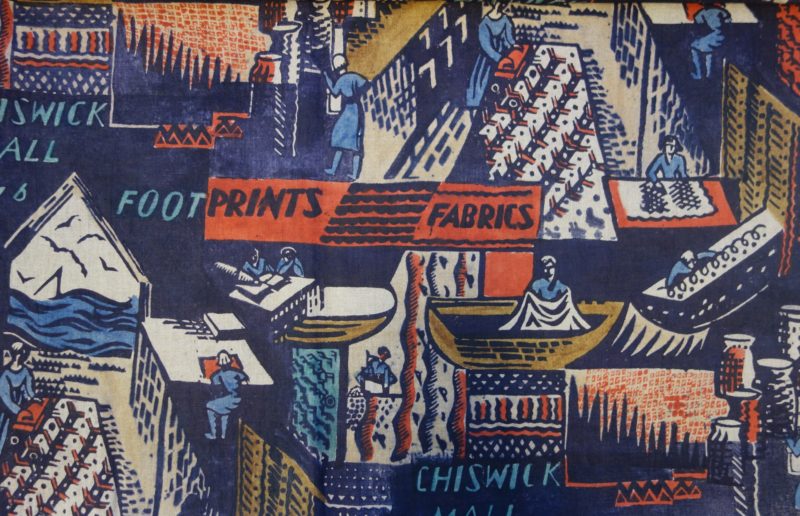Dissertation time has come for us MA students. My research on Footprints, a London-based fabric printing workshop active during the interwar years, has led me to Gunnersbury Museum, a local history museum based in Gunnersbury Park, London. While the museum is currently closed for renovation, the curators were kind enough to let me research their small but exciting collection of Footprints artefacts.
Footprints was established at Durham Wharf, Hammersmith in 1925. It produced hand block printed fabrics and garments which were sold at Modern Textiles, a small shop opened by Elspeth Anne Little at 46 Beauchamp Place, Knightsbridge in 1926.
Footprints was mainly staffed by female art students or recent graduates of the Central School of Arts and Crafts. It was initially run by Gwen Pike, a painting and block printing graduate of Birmingham School of Art. After Pike’s death in 1929 the workshop was taken over by Joyce Clissold, who had previously worked at Footprints as a Central School student. Clissold did most of the designing and carving of the lino blocks, while her employees prepared the dyes and did the printing.
Clissold eventually opened a shop called Footprints at 94 New Bond Street in 1933, followed by a second shop at 22 Knightsbridge in 1935. Both shops were located in London’s fashionable West End and attracted celebrity customers such as the actresses Yvonne Arnaud, Gracie Fields and Anna Neagle.
At Footprints, one could purchase lengths of hand block printed and painted fabrics, or small ready-made items such as scarves, shawls or hats. Customers who desired custom-made garments had their measurements were taken by ‘Madame Blanche’ – the working name of the in-house dressmaker Mrs. White.


The Shawl of her Dreams!
Footprints also advertised their fabric painting and printing services directly to dressmakers, which I discovered through an early publicity leaflet I came across in Gunnersbury Museum’s collection. In the leaflet, Footprints’ fabrics were described as “embroidered in dyes”. They were hand block printed and painted in “lovely colours, vivid or demure; designs flamboyant or modest”. For even more novelty and exclusiveness, the dressmaker’s own design could be carried out by Footprints.
The leaflet’s cover is gorgeously illustrated with a printed design of a fashionably short-haired lady. Seen from the back, she wears a fringed shawl with a bold floral design in blue, green, pink and purple. The illustration reminded me of a photograph from the Central Saint Martins Museum and Study Collection, which is the largest collection of Joyce Clissold and Footprints artefacts. In this photograph taken around 1927 Joyce Clissold poses wearing a shawl of her own design.

Finally, the leaflet conjured up a scene at a dressmaker’s establishment where the customer, or “Madame”, lays her eyes on just the perfect addition to her wardrobe: “That five minutes in the showroom on the way to be fitted. That’s when Madame’s eye roves… The SHAWL of her dreams! The SCARF that just goes with the tailor-made. The irresistible little COAT. The intriguing POCHETTE. She falls to it so gladly”.
Oh, imagine how it must feel to find your dream shawl, or any other kind of garment you wish to add to your wardrobe, embroidered in dyes of lovely colours…

By Nelleke Honcoop
Further reading:
Clark, Hazel. ‘Joyce Clissold and the “Footprints” Textile Printing Workshop’. In Women Designing: Redefining Design in Britain Between the Wars, edited by Jill Seddon and Suzette Worden, 82–88. Brighton: University of Brighton, 1994.
Gunnersbury Museum is currently closed for renovation, but will reopen in June 2018. See: http://www.visitgunnersbury.org/collections/.













